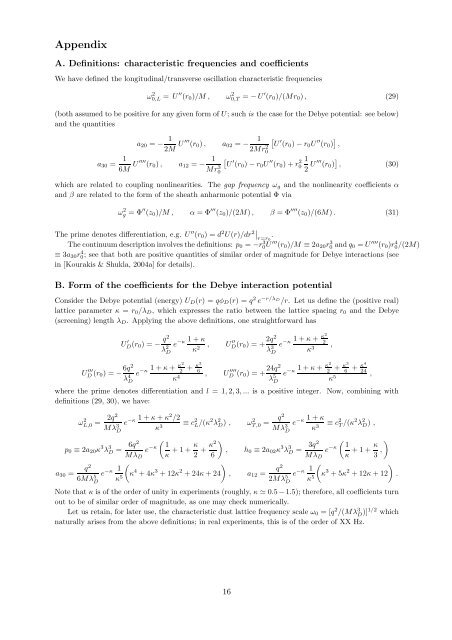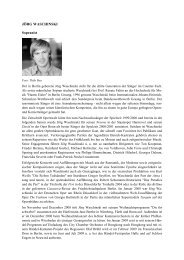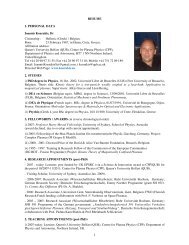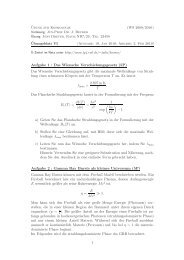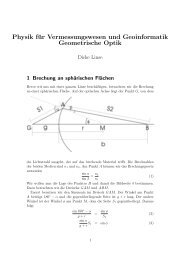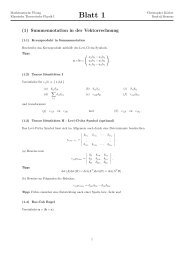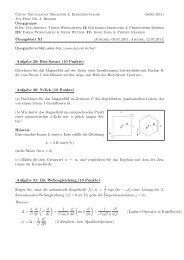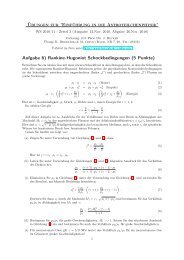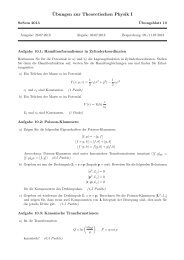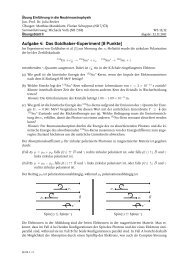View - Theoretische Physik IV - Ruhr-Universität Bochum
View - Theoretische Physik IV - Ruhr-Universität Bochum
View - Theoretische Physik IV - Ruhr-Universität Bochum
Create successful ePaper yourself
Turn your PDF publications into a flip-book with our unique Google optimized e-Paper software.
Appendix<br />
A. Definitions: characteristic frequencies and coefficients<br />
We have defined the longitudinal/transverse oscillation characteristic frequencies<br />
ω 2 0,L = U ′′ (r 0 )/M , ω 2 0,T = − U ′ (r 0 )/(Mr 0 ), (29)<br />
(both assumed to be positive for any given form of U; such is the case for the Debye potential: see below)<br />
and the quantities<br />
a 20 = − 1<br />
2M U ′′′ (r 0 ), a 02 = − 1<br />
a 30 = 1<br />
6M U ′′′′ (r 0 ), a 12 = − 1<br />
Mr 3 0<br />
2Mr 2 0<br />
[<br />
U ′ (r 0 ) − r 0 U ′′ (r 0 ) + r 2 0<br />
[<br />
U ′ (r 0 ) − r 0 U ′′ (r 0 ) ] ,<br />
1<br />
2 U ′′′ (r 0 ) ] , (30)<br />
which are related to coupling nonlinearities. The gap frequency ω g and the nonlinearity coefficients α<br />
and β are related to the form of the sheath anharmonic potential Φ via<br />
ω 2 g = Φ ′′ (z 0 )/M , α = Φ ′′′ (z 0 )/(2M), β = Φ ′′′′ (z 0 )/(6M). (31)<br />
The prime denotes differentiation, e.g. U ′′ (r 0 ) = d 2 U(r)/dr 2∣ ∣<br />
r=r0<br />
.<br />
The continuum description involves the definitions: p 0 = −r 3 0 U ′′′ (r 0 )/M ≡ 2a 20 r 3 0 and q 0 = U ′′′′ (r 0 )r 4 0 /(2M)<br />
≡ 3a 30 r 4 0; see that both are positive quantities of similar order of magnitude for Debye interactions (see<br />
in [Kourakis & Shukla, 2004a] for details).<br />
B. Form of the coefficients for the Debye interaction potential<br />
Consider the Debye potential (energy) U D (r) = qφ D (r) = q 2 e −r/λD /r. Let us define the (positive real)<br />
lattice parameter κ = r 0 /λ D , which expresses the ratio between the lattice spacing r 0 and the Debye<br />
(screening) length λ D . Applying the above definitions, one straightforward has<br />
U D(r ′ 0 ) = − q2<br />
λ 2 e −κ 1 + κ<br />
D<br />
κ 2 , U D(r ′′<br />
0 ) = + 2q2<br />
κ2<br />
−κ<br />
1 + κ +<br />
2<br />
λ 3 e<br />
D<br />
κ 3 ,<br />
U D ′′′ (r 0 ) = − 6q2<br />
κ2<br />
−κ<br />
1 + κ +<br />
2<br />
λ 4 e + κ3<br />
6<br />
D<br />
κ 4 , U D ′′′′ (r 0 ) = + 24q2<br />
κ2<br />
−κ<br />
1 + κ +<br />
2<br />
λ 5 e + κ3<br />
6 + κ4<br />
24<br />
D<br />
κ 5 ,<br />
where the prime denotes differentiation and l = 1, 2, 3, ... is a positive integer. Now, combining with<br />
definitions (29, 30), we have:<br />
ωL,0 2 = 2q2<br />
Mλ 3 e −κ 1 + κ + κ2 /2<br />
D<br />
κ 3 ≡ c 2 L /(κ2 λ 2 D ) , ω2 T,0 = q2<br />
Mλ 3 e −κ 1 + κ<br />
D<br />
κ 3 ≡ c 2 T /(κ2 λ 2 D ) ,<br />
(<br />
p 0 ≡ 2a 20 κ 3 λ 3 D = 6q2 1<br />
e −κ<br />
Mλ D κ + 1 + κ )<br />
(<br />
2 + κ2<br />
, h 0 ≡ 2a 02 κ 3 λ 3 D = 3q2 1<br />
e −κ<br />
6<br />
Mλ D κ + 1 + κ )<br />
3 ,<br />
a 30 =<br />
q2<br />
6Mλ 5 e −κ 1 )<br />
(κ 4<br />
D<br />
κ 5 + 4κ 3 + 12κ 2 + 24κ + 24<br />
, a 12 = q2<br />
2Mλ 5 e −κ 1 (κ 3<br />
D<br />
κ 5 + 5κ 2 + 12κ + 12<br />
Note that κ is of the order of unity in experiments (roughly, κ ≃ 0.5 −1.5); therefore, all coefficients turn<br />
out to be of similar order of magnitude, as one may check numerically.<br />
Let us retain, for later use, the characteristic dust lattice frequency scale ω 0 = [q 2 /(Mλ 3 D )]1/2 which<br />
naturally arises from the above definitions; in real experiments, this is of the order of XX Hz.<br />
)<br />
.<br />
16


